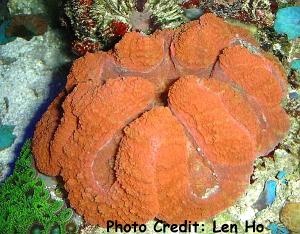
By Bob Goemans

Likely Reef Tank Suitable
Likely Fish-Only Tank Suitable
Range: Indo-West Pacific Ocean: Red Sea to western, northern, and eastern coasts of Australia, east to Tahiti, and north to Southern Japan.
Natural Environment: Inhabits protected upper reef slopes and fore-reef slopes, and is sometimes found covering extensive areas, e.g., 15 - 30 feet (5 - 10 m) across. Colonies are flat to hemispherical and may include colonies having different colors and polyp mantles of different texture. Specimens are sometimes found with two or more colors, where valley wall coloration differ from central mouth areas.
General Husbandry: This is a hardy and disease free stony coral and commonly available, and often available in different shades of colors. It is also a very good coral for those fairly new to reef keeping, as its care requirements are quite simple, as it should be placed where water movement is slow to moderate, and with moderate lighting.
Since it is somewhat none aggressive, it should be placed where other more aggressive corals will not come in contact with it. If placed high in the aquarium, it should be so situated that bull dozing critters will not dislodge it. Falling injuries do not seem to heal very well, and can lead to infections/micro alga infestations that cause tissue recession. However, when placed in the correct environmental conditions, growth is quite fast.
Feeding tentacles are usually displayed during evening hours, but sometimes are seen throughout the daytime. Should increased growth be desired, direct feeding during the time periods when feeding tentacles are displayed can be attempted. Zooplankton-type products such as rotifers, newly hatch brine shrimp, or Cyclop-eeze can be offered, yet would recommend limiting feeding attempts to no more than once every few weeks. Specimens I've fed more often have taken on odd shapes, with tissue expanding and hanging/drooping loosely in some areas. When feeding stopped altogether, tissue regained its original shape. In fact, I've found this 'over supply' of foodstuffs to cause similar shape changes in some other species.
Taxonomy:
Kingdom: Animalia
Phylum: Cnidaria
Class: Anthozoa
Subclass: Hexacorallia
Order: Scleractinia
Family: Mussidae
Genus: Lobophyllia
FYI: When purchasing a specimen with highly inflated flesh, do not remove it from the water as the weight of the water in the flesh may damage or tear the flesh. Gently shake the specimen and allow the flesh to retract somewhat before removing.
Experience Level: Beginner
Diet: Photosynthetic/Plankton feeder
Temperament: Semi-aggressive
Aquarium Environment: Reef or fish-only aquarium
Coral Safe: With caution
Fish Safe: Yes
Invertebrate Safe: Yes
Acclimation Time: 30 minutes+
Aquarium Hardiness: Hardy
Calcium (Ca): 380 - 430 mg/l
Alkalinity: 2.5 - 3.0 meq/l
Phosphate (PO4): <0.05 mg/l
Magnesium (Mg): approx. 1350 mg/l (relate to specific gravity)
Strontium (Sr) 8 - 10 mg/l
Temperature Range: 74 - 83°F (23 - 28°C)
Minimum Tank Size: 50 gallons
Lighting: PAR 350+
Water Movement: WM 1 - 2
Specific Gravity: 1.023 - 1.025
pH: 8.0 - 8.4
Iodine/Trace Elements Monitor/as necessary to maintain quality seawater.
